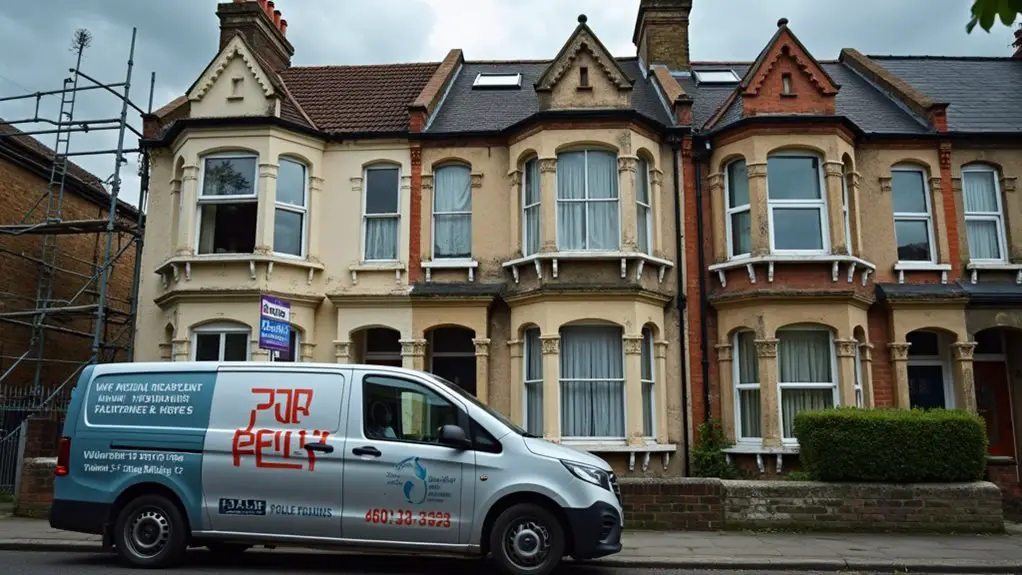Landlords across the country are raising rents to offset considerable cost increases. You’ll find 85% of property owners implemented rent hikes in 2024, with nearly one-third raising rates by 6-10%. These increases reflect genuine financial pressures including surging property taxes, insurance premiums, maintenance costs, and regulatory compliance expenses. While national median rents now stand 35% above pre-pandemic levels, these adjustments help owners maintain viable properties amid the complex economic terrain.

As property management expenses continue to soar nationwide, landlords are increasingly caught in a financial squeeze that’s forcing difficult decisions about rental rates. You’ve likely noticed that 85% of property owners increased rents in 2024, with nearly one-third implementing substantial hikes between 6-10%. These increases aren’t arbitrary but reflect genuine cost pressures facing today’s rental property owners.
The financial strain stems from multiple sources. Property taxes have climbed dramatically alongside rising property values, while insurance premiums have surged, especially in regions prone to natural disasters. You’ll find landlords in hurricane and wildfire-vulnerable areas facing particularly steep insurance increases that directly impact their bottom line.
Landlords battle rising property taxes and insurance hikes that hit disaster-prone regions especially hard.
Maintenance costs present another considerable challenge. Supply chain disruptions have inflated the price of materials, while labor shortages in the property management sector have driven up wages for contractors and staff. When repairs can’t be completed promptly due to workforce shortages, emergency service fees often follow, further straining budgets.
Energy and utility expenses add to the mounting pressure. Landlords covering common area utilities or those offering bundled utility services face higher operational costs that must be offset. While energy-efficient upgrades offer long-term savings, they require substantial upfront investment that impacts immediate cash flow.
The regulatory environment has grown increasingly complex as well. New tenant protection laws create additional compliance requirements, with 17% of landlords reporting difficulties maneuvering these legal obligations. The associated administrative expenses and potential legal risks represent yet another cost factor. According to recent data, 82% of landlords experienced increased ownership costs, with over a quarter reporting that their costs have risen by more than 20%.
Technology presents both solutions and challenges. Property management software could streamline operations, but 35% of landlords cite cost concerns as a barrier to adoption. These systems, while potentially beneficial, represent another expense in an already strained budget. National median rents have skyrocketed 35% higher than pre-pandemic levels, reflecting the cumulative effect of these operational challenges.
When you see rent increases on your lease renewal, they typically reflect these genuine operational challenges rather than simple profit-seeking. Today’s landlords are managing a complex economic climate where multiple cost factors necessitate rent adjustments to maintain viable properties.
Frequently Asked Questions
How Do Rising Rents Affect Long-Term Housing Affordability?
When rents rise faster than your income, you’re facing a shrinking financial future.
You’ll struggle to save for homeownership as more of your budget goes toward housing. This situation affects your ability to build wealth and economic security.
Rising rents particularly impact low-income families and communities of color. Many of you now spend over 30% of income on housing, creating cascading financial problems.
Local governments are trying to help, but federal funding cuts threaten long-term affordable housing solutions.
What Legal Protections Exist for Tenants Facing Sudden Rent Increases?
As a tenant facing sudden rent increases, you’re protected by several legal measures.
You must receive advance written notice based on your residency length: 30-90 days depending on how long you’ve lived there.
In rent-controlled areas, there are limits on how much your rent can increase.
The law also prohibits retaliatory increases if you’ve reported code violations or discriminatory hikes based on protected characteristics like race or gender.
You can challenge excessive increases in some jurisdictions through legal channels.
Are Government Subsidies Available to Help Struggling Renters?
Yes, you can access several government subsidies to help with rental costs. The Emergency Rental Assistance Programs (ERA) have provided over $46 billion in support since the pandemic began.
You’ll find two main programs: ERA1 ($25 billion) and ERA2 ($21.55 billion), covering rent, utilities, and other housing expenses.
Your state or local government manages these funds with specific eligibility requirements. Contact your local 211 program for referrals to nearby assistance.
HUD also offers additional housing support programs for longer-term stability.
How Do Rent Increases Compare to Average Wage Growth?
Since 2020, rent increases have greatly outpaced wage growth. Your rent costs have risen by 28.7% for typical apartments and 42.9% for single-family homes, while median household income has grown only 22.5% to about $82,000.
This widening gap creates serious affordability challenges for you as a renter.
The disparity reduces your disposable income and limits your ability to save for homeownership or cover other crucial expenses.
What Alternatives Exist for Those Priced Out of Rental Markets?
If you’re priced out of rental markets, you have several alternatives to contemplate.
You can explore public housing or Housing Choice Vouchers, though waitlists are often long.
Housing cooperatives and shared living arrangements offer lower costs through resource sharing.
Community land trusts maintain affordability by separating land from housing ownership.
You might also contemplate manufactured homes, relocating to less expensive areas, or exploring micro-apartments and tiny homes that minimize square footage to reduce costs.


